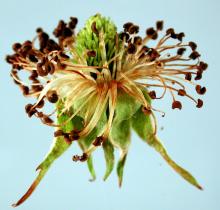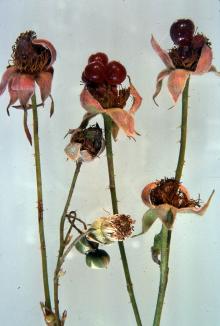Cause Hapalosphaeria deformans, a fungus. This disease affects 'Boysenberry', 'Youngberry', 'Marion', 'Evergreen', and wild trailing blackberry. It also has been described on raspberries in Europe. The disease is severe in some plantings; severity varies markedly from year to year. Rain splashes spores from infected flowers to axillary buds of primocanes during bloom. The infection process is not well understood but occurs in summer.
Symptoms Stamens of infected flowers are flattened against the petals instead of in an upright ring. Anthers are swollen, brown, and do not shed pollen. Since sporulation occurs before the flower opens, the flower has a white, powdery appearance when open. Flowers may have symptoms on sepals: leaf-like structures at the tips and double the number of petals. Some species of blackberry may show a witches' broom of the inflorescences. If fruit develops, the receptacle is constricted, and a number of druplets either fail to develop or do so unevenly. Ripening may be uneven, and fruit is hard and difficult to remove from the receptacle.
Cultural control
- The alternate-year fruiting system controls the disease by removing the inoculum source from above developing primocanes.
- Use plant spacing and canopy management that promotes good air circulation.
Chemical control Direct sprays onto primocanes in the every-year fruiting system any time between flowering and harvest.
- Captan 80 WDG at 2.5 lb/A. Do not apply within 3 days of harvest. Although this disease is not on the label, Captan has been shown to be effective. Group M4 fungicide. 48-hr reentry.
References Martin, R.R., Ellis, M.A., Williamson, B., and Williams, R.N. 2017. Compendium of Raspberry and Blackberry Diseases and Pests. 2nd edition. St. Paul, MN: APS Press.
Dickens, J.S.W. 1967. Epidemiology of stamen blight of raspberry. Annals of Applied Biology 60:343-351.




